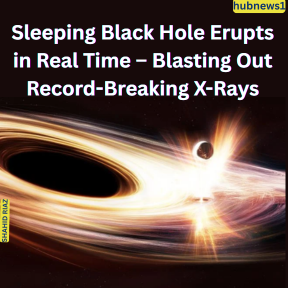
Sleeping Black Hole Erupts in Real Time – Blasting Out Record-Breaking X-Rays
hubnews1-Sleeping Black Hole Erupts in Real Time – Blasting Out Record-Breaking X-Rays ESA’s XMM-Newton and other X-ray telescopes are observing gargantuan bursts of energy called quasi periodic eruptions (QPEs) that challenge theories now in place. Unlike anything previously witnessed, the intense flashes can be rewriting the playbook for how black holes behave, grow, and interact with their environment.
XMM-Newton Sees Extremely Unusual Black Hole Activity
The XMM-Newton telescope of the European Space Agency is assisting scientists to observe the most powerful and longest bursts of X-rays ever observed from a recently revived black hole. Witnessing this unusual event in real-time provides researchers with a rare opportunity to learn more about the nature of black holes and what triggers these extreme bursts.
Supermassive black holes, a million times more massive than our Sun, are thought to be at the center of galaxies. Yet although they are gigantic, they’re sometimes difficult to find. Not unlike the conventional picture of black holes as endlessly consuming matter, most of them spend long periods quiet and in repose.
A Sudden Awakening in Virgo
That is what happened at the black hole in the middle of SDSS1335+0728, a relatively unremarkable galaxy roughly 300 million light-years from Earth in the constellation Virgo. After being quiet for decades, this black hole roared to life and started pumping out intense, unprecedented X-ray bursts.
READ MORE:Pink Moon: When To See Spring’s First Full Moon Rise In Blaze Of Color
The first indicators of activity manifested in the later part of 2019 when the galaxy surprisingly started emitting very bright light, catching the attention of astronomers. Having observed it for some years, they made a conclusion that the remarkable variations they observed were most likely caused by the black hole ‘waking up’ – turning to an active stage. The compact, luminous, central zone of the galaxy is currently listed as an active galactic nucleus, ‘Ansky’ in nicknames.
Triggering Telescopes and Tracking Light
“When we first detected Ansky shine in optical images, we initiated follow-up observations with NASA’s Swift X-ray space telescope, and we examined archived observations with the eROSITA X-ray telescope, but then we did not find any sign of X-ray emission,” says Paula Sánchez Sáez from the European Southern Observatory, Germany, and project leader of the first team to study the activation of the black hole.”.
XMM-Newton Uncovers Latent Energy Patterns
“XMM-Newton was instrumental in our research. It is the sole X-ray telescope sensitive enough to pick up the weaker X-ray background radiation between the flashes. With XMM-Newton, we were able to gauge just how dim Ansky becomes, which allowed us to estimate just how much energy Ansky unleashes when it glows and begins to flash.”
Deciphering Perplexing Behavior
The gravity of a black hole traps matter that approaches too close and may tear it apart. The matter of an ensnared star, for instance, would be distributed into a scorching, luminous, fast-rotating disc known as an accretion disc. The prevailing opinion is that QPEs are generated by an object (which may be a star or even a small black hole) coming in contact with this accretion disc and they have been attributed to the annihilation of a star. However, there is no proof that Ansky destroyed a star.
The rare nature of Ansky’s intermittent outbursts led the researchers to think outside the box. The accretion disc might be created through gas that was trapped by the black hole in its vicinity, and not the remains of a disintegrated star. Under this condition, the X-ray flares would be due to extremely energetic shocks in the disc, triggered by a small stellar object passing through and disturbing the orbiting matter, repeatedly.
A Black Hole Unlike Any Other
“Ansky’s X-ray bursts are a factor of ten longer and a factor of ten brighter than what we observe in a standard QPE,” says Ansky team member and Massachusetts Institute of Technology, USA, PhD student Joheen Chakraborty.
“Every one of these eruptions is putting out a hundred times more energy than we’ve seen anywhere else. Ansky’s eruptions also have the longest cadence ever seen, of around 4.5 days. This is stretching our models to the limit and contradicting our current understanding of how these X-ray flashes are being produced.”
Seeing the Cosmos Unfold in Real Time
Having the ability to observe Ansky changing before their eyes is an unparalleled event for astronomers to gain greater insight into black holes and the explosive processes they drive.
“For QPEs, we’re still at the stage where we have more models than data, and we require additional observations to make sense of what’s going on,” says ESA Research Fellow and X-ray astronomer, Erwan Quintin.
“We believed that QPEs were due to small cosmic objects being caught by much bigger objects and falling into them. Ansky’s eruptions are giving us a different message. These periodic bursts are probably also linked to gravitational waves that ESA’s upcoming mission LISA may be able to detect.”
It’s important to get these X-ray observations that will fill in the picture with the gravitational wave data and allow us to unravel the mysterious behavior of massive black holes.
The Most Complete Map of the Human Cell Ever Built – AI and Imaging Power
Using robust imaging and AI tools like GPT-4, they exposed hundreds of previously unknown protein functions and found decisive cellular assemblies tied to childhood leukemias. This map not only transforms cell biology research but can also upend our molecular-level understanding of disease.

Mapping the Human Cell: A 400-Year Journey
Researchers have been trying to chart the human cell ever since the invention of the microscope over 400 years ago. Nonetheless, large sections of the cell remain unmapped.
“We have all of the proteins that are found in our cells, but how they come together to then carry out the function of a cell is still quite unknown across cell types,” said Leah Schaffer, Ph.D., a postdoctoral research scholar at UC San Diego School of Medicine.
A New Cellular Atlas Emerges
Schaffer and her group at UC San Diego, in collaboration with researchers at Stanford University, Harvard Medical School, and the University of British Columbia, have now created a high-resolution, interactive map of U2OS cells — childhood bone tumor cells. By combining high-resolution microscopy with data on protein-protein interactions, the scientists mapped the internal organization and structure of proteins within these cells.
Their study unveiled novel protein functions unknown before and sheds new light on how mutations lead to disease, including childhood cancer. The map also provides a blueprint for building similar atlases of other human cell types. The study appeared in Nature on April 9, 2025.
Why We Still Don’t Fully Understand Cells
From cell biology 101 and picture books of cells, you would think that we know all there is to know about a cell. What is surprising is that for no type of human cell do we actually have a satisfactory parts catalog and assembly manual,” co-senior author Trey Ideker, Ph.D., professor of medicine, adjunct professor at Jacobs School of Engineering and member of Moores Cancer Center at UC San Diego, reported.
Mapping the Map: Imaging and Protein Interactions
The researchers used an affinity purification protocol to purify individual proteins and capture their binding to other proteins. They also looked at more than 20,000 snapshots of the inside of fluorescent-dye-stained cells to shed light on the location of target proteins from the Human Protein Atlas. Combining these data on more than 5,100 proteins revealed 275 distinct complexes of proteins with different sizes within U2OS cells.
READ MORE:How to Create Fun Science Lessons for Engaging Learning
“Historically, scientists have been biased by the notion that one gene codes for one protein that has one function,” said co-senior author Emma Lundberg, Ph.D., associate professor of bioengineering and of pathology at Stanford University. “However, there is now an increasing number of known multifunctional proteins, and while we’re probably still underestimating how many there are, this study demonstrates the importance of multimodal data integration to reveal these multifunctional properties.”
Every Living Creature on Earth Comes from a Single Ancestor — And It’s Much Older than We Thought
Scientists have only recently revised the history of life on Earth, and it begins much earlier than anyone anticipated. New genetic evidence suggests a cryptic ancestor that flourished in hostile environments.
A revolutionary new report has extended the history of life’s emergence further into the past than ever before. Scientists have calculated that the last universal common ancestor (LUCA) – the microbe from which all living things on our planet are derived – could have lived as recently as 4.2 billion years ago, only 400 million years after our planet had come into being.
Tracing Life’s Origins Through Molecular Clocks
LUCA is the postulated single-celled ancestor from which all the domains of life—Bacteria, Archaea, and later Eukaryotes—evolved. Even though LUCA was not the initial living thing, it is the earliest confirmed common ancestor of all the living organisms that have left behind a genetic heritage.
Scientists led by Dr. Edmund Moody from the University of Bristol used a technique called phylogenetic analysis to estimate LUCA’s age. This method examines genetic mutations across thousands of species to understand when lineages diverged.
READ MORE:How and Where to See the “Double Sunrise” Solar Eclipse Saturday Morning
Over time, genetic mutations accumulate at relatively stable rates. By comparing differences in DNA sequences among diverse modern organisms, the researchers effectively used an “evolutionary clock” to rewind the timeline back to LUCA’s emergence.
Notably, the divergence time for certain species is already established from the fossil record. This enabled the researchers to calibrate their molecular clock and determine LUCA’s probable age with more certainty. The outcome was a new estimate of 4.2 billion years, much higher than the commonly quoted figure of 3.8 billion years.
A Surprisingly Complex Microbe
Even though LUCA existed in a period without multicellular organisms or atmospheric oxygen, it could hardly have been primitive. The study indicates that LUCA was biologically sophisticated, much like modern prokaryotes. It probably had DNA-based genetic systems, protein synthesis ribosomes, and even ATP metabolism – characteristics found in all living cells today.
Most compelling is perhaps the suggestion that LUCA possessed a primitive immune system. The researchers state, “even by 4.2 billion years ago, our ancestor was conducting an arms race against viruses.” This imples that LUCA was not existing in a sterile environment, but within an active world where viruses represented threats that necessitated nascent forms of biological defense.
Living at the Edge of Habitability
LUCA likely flourished in harsh aquatic conditions, like hydrothermal vents, where high pressure and mineral-laden waters offered the conditions required for chemical reactions vital to life. Such environments are also at the heart of a number of top hypotheses for the origin of life, including the alkaline vent theory.
Although its origins date back to antiquity, LUCA could have formed part of an ancient microbial community. Scientists think it lived alongside other ancient microbes such as methanogens, microbes that probably lived off LUCA’s waste products.
As Dr. Tim Lenton of the University of Exeter explained, “its waste would have been food for other microbes… that would have helped to create a recycling ecosystem.” This initial interaction between organisms could be the first recorded instance of ecological cycling, a basic process in contemporary ecosystems.
A Deeper Look at Early Evolution
The research, published in Nature Ecology & Evolution, combines information from a variety of scientific fields such as evolutionary biology, genomics, and Earth sciences. The scientists used a method called gene-tree/species-tree reconciliation, which takes into account the intricate sharing of genes among lineages, to rebuild LUCA’s biology with higher resolution than before.
“This allows us to say with some confidence—and assess that level of confidence—on how LUCA lived,” said Dr. Tom Williams, a co-author of the study.
Professor Davide Pisani further explained that LUCA was already “exploiting and modifying its environment,” and even though it wasn’t alone, its biological characteristics laid the foundation for the diversity of life that would come next. The research also supports new views on the habitability of early Earth.
As Dr. Sandra Álvarez-Carretero said, “we did not expect LUCA to be so old… However, our results fit with modern views on the habitability of early Earth.” The result is profound: if life is able to establish and diversify so rapidly on Earth after Earth’s formation, then it must be the same for Earth-like planets throughout the universe.
FAQ:
1. What does “sleeping black hole” mean?
A “sleeping” or dormant black hole is one that is not actively consuming nearby matter, making it relatively quiet. In this case, the black hole suddenly woke up and began devouring material, leading to a massive X-ray eruption.
2. How was this eruption detected in real time?
Astronomers observed the event using advanced X-ray telescopes (such as NASA’s Chandra X-ray Observatory or ESA’s XMM-Newton), which captured the sudden, intense burst of high-energy radiation.
3. Why is this X-ray blast record-breaking?
The eruption produced the brightest or most energetic X-ray emissions ever recorded from a previously dormant black hole, offering new insights into black hole behavior.
4. What caused the black hole to erupt?
The likely trigger was a star or gas cloud passing too close, getting torn apart by gravity (a tidal disruption event), and feeding the black hole in the process.
5. Where is this black hole located?
While the exact details depend on the study, such events typically occur in distant galaxies. Researchers will provide coordinates once the findings are peer-reviewed.
6. Does this eruption pose any danger to Earth?
No. Even if this occurred in our galaxy, the distance is so vast that Earth would not be affected.
7. What does this discovery mean for science?
Real-time observations of a black hole’s awakening help scientists understand:
- How black holes suddenly activate
- How they consume matter
- How they generate extreme radiation
8. Where can I learn more?
Check updates from NASA, ESA, or leading astrophysics journals like The Astrophysical Journal for the official published study.
black holes star,black holes,when dad catches you not sleeping,black hole vs star,black hole’s,black history,game disc stuck in xbox one,black history month,xbox one disk stuck in the tray,disk stuck in xbox one,stuck game in xbox one,disc stuck in xbox one,xbox one disk stuck in drive,black,stuck disc in xbox one,interesting facts,subway surfers speedrun world record,kaicenat’s mom reaction to him cussing on stream..,anime,after effects tutorial






